A stones throw away from Lisbon’s cathedral is a small pilgrimage site with great historical significance – St Anthony Church and Museum; here is a complete guide.
The small baroque-style church is one of Lisbon’s valuable architecture masterpieces and cultural landmarks, evolving from a small chapel to the grand basilica we see today.
It was constructed in the memory of St. Anthony of Padua, a famous saint known far and wide as a match-maker. St. Anthony himself was born at the site where the church stands today.
As one of the oldest churches in Lisbon, this site is a must visit when in Lisbon, especially for those who love to explore archaeological structures, artifacts, and religious manuscripts.
History of St. Anthony Church
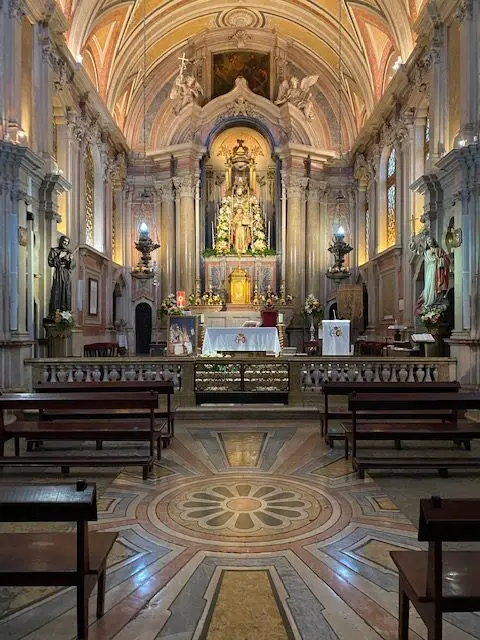
Known as Igreja de Santo António in Portuguese, St Anthony is located in Lisbon, on the same hillside as the Lisbon Cathedral. It is actually in front of, or across the street from, the cathedral.
The church was originally constructed in the 14th century, starting out as a small chapel dedicated to St. António.
As it became a place of pilgrimage among locals with time, a larger church was constructed. By early 17th century, the church was complete but then was destroyed during the 1755 Lisbon earthquake.
The devastating earthquake collapsed the church’s dome. Many frescoes, sculptures, and other valuable artworks were destroyed as well. The church would take several decades to be renovated. The reconstruction began in 1757.
What will you see at St. Anthony’s Church?
In the yard of St. Anthony’s church, a bronze statue of St. António holding baby Jesus greets you at the gate. It’s almost as if St. António is welcoming you to ascend up the steps to enter through the church’s doorway.
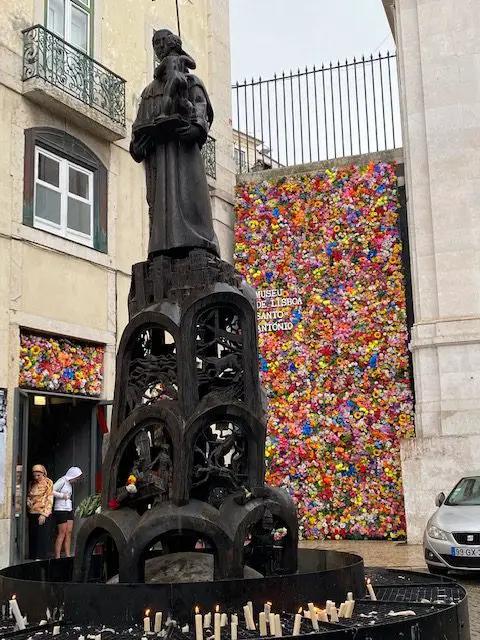
The Church’s facade & interior
The church’s facade features a combination of baroque, gothic and neoclassical styles dating back to the 17th and 18th centuries.
Sculptures of saints and angels decorate the space. A large Rose window along with a large portal with a pointed arch forms the façade of the church.
Another feature that stands out is the two simple-design towers that flank the archway. The two towers are topped with domes, and locals and tourists alike use them as a landmark feature since they are visible from a distance.
The church’s interior looks impressive as well. The interior architecture combines a high nave, ornate chapels, and an underground vault. Ornate frescoes and gilded carvings decorate the church’s interior. Thanks to large stained-glass windows and a dome-shaped ceiling, the interior is well-illuminated, bringing a calming, serene atmosphere.
What to see inside the church:
Ornate baroque altar –

The baroque-ornate structure features rich decorations. Above the altar hangs a large canvas painting in honor of the patron saint. You can stop by here for a silent prayer.
Visit the chapels –
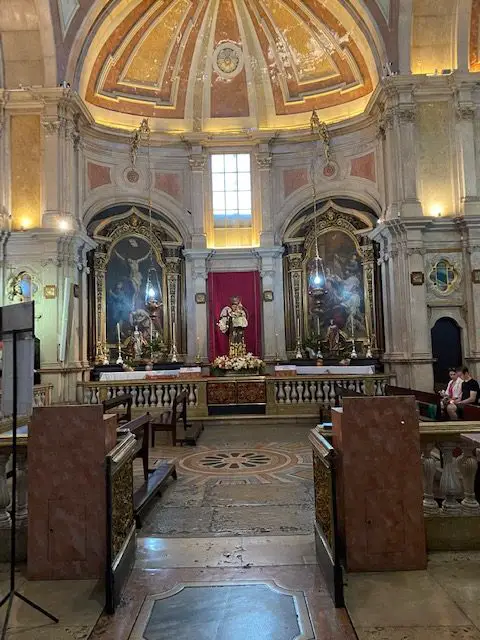
The nave has several chapels each dedicated to a religious saint with each chapel featuring distinct artwork and decorations. Inside the main chapel, you’ll find a wooden statue of St. Anthony dating back to before the 1755 earthquake. You’ll find paintings and statues depicting Saint António’s life and his family history.
Visit The crypt –
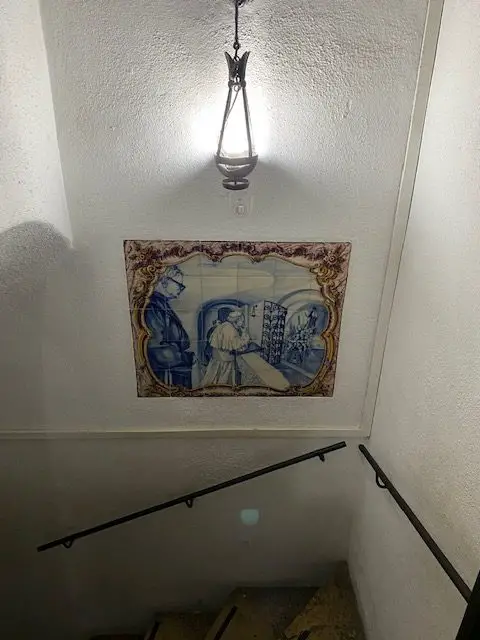
You can visit the crypt to say a prayer or explore its history. The crypt represents the preserved spaces underneath the church. It is believed this underground vault is the site where St. Anthony was born – his tomb and relics can be found here. Also, when you visit the crypt, you’ll get to see a modern tile panel (azulejo style) memorializing the Pope John Paul II visit to the site in 1982.
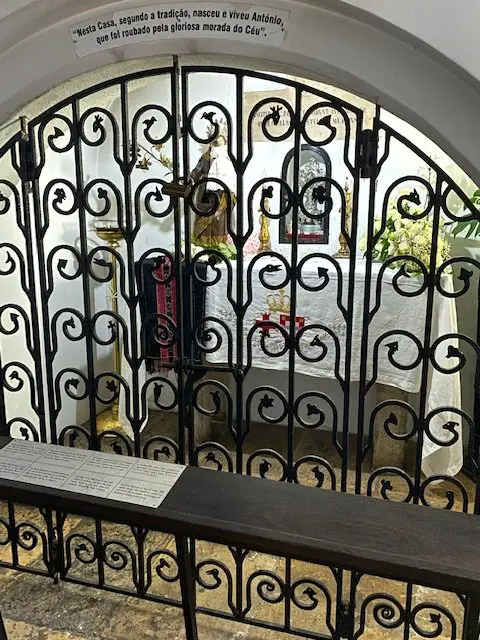
Visit the sacristy –
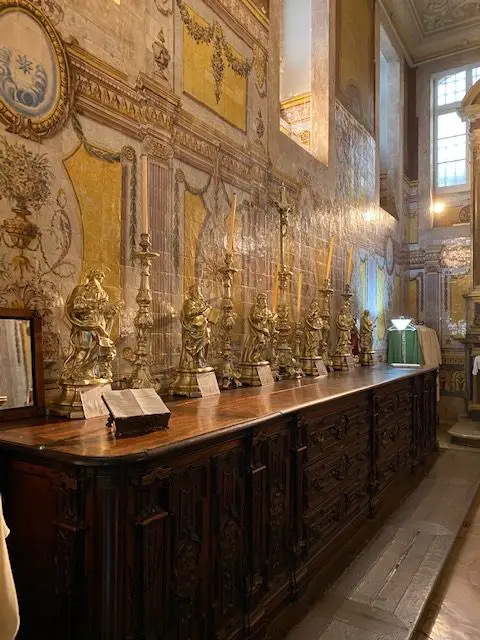
Adjacent to the main altar is a room dedicated for prayer. You can visit the sacristy for a word of prayer or to adore the religious artifacts and artworks that decorate the room.
Visit the altar where the relics Saint Justina of Padua remains lie –
her remains were brought here from Rome in 1777.
Museum of Saint Anthony
The church of Saint Anthony has a small museum that houses religious artifacts, manuscripts, and sculptures that evoke veneration of the saint.
Although it’s like “the world’s smallest museum,” it offers quite a unique adventure for those who want to dive into the history of the saint that once lived at this site.
The museum has manuscripts and books containing the rich history of the church. It houses historical items and religious artifacts, and other devotional items that tell the unique story of Saint Anthony of Padua. There is a section that offers interactive slides with detailed philosophies of Saint António.
Although quite a small museum, your visit here will be a unique one. There is a spot you can take a selfie, with an option to provide your email to have it sent to you.
How to get to St. Anthony Church and Museum
GPS Coordinates: 38.710168789877514, -9.133825448087737
Tram 28 and bus 737 pass by the church. Alternatively, you can take a Tuk Tuk or if you’re in downtown Lisbon, it takes 5 -10 minutes, walking through the tracks heading uphill.
If you have a Lisbon card, you get a free ticket to ride the tram, train, metro, or the bus.
Admission to the church and Museum
It’s free to enter St. Anthony church. But if you want to visit the museum, entry is €3 per ticket.
What else is nearby?
- Sé Cathedral – Lisbon’s Cathedral is directly across the street from the Igreja de Santo AntMain Altar, Igreja de Santo António. My article: Lisbon Cathedral | All you need to know before you go
- Aljube Museum of the Resistance – A little further up the road, still across from the cathedral, is the Aljube Museum ofthe Resistance. The building was formerly a political prison, and it this museum is an excellent opportunity to learn about the history of Portugal in the 20th century.
- Miradouro da Santa Luzia – This beautiful and romantic viewpoint is a little higher up the road.
- Miradouro das Portas do Sol – Miradouro Portas do Sol viewpoint – What you need to know Another of Lisbon’s best viewpoints is just past the Miradouro and Church of Santa Luzia.
- Castelo de São Jorge – Peel off to the left and head uphill to find Lisbon’s castle. For more information, read my In and around Castelo de São Jorge – Lisbon’s castle
Feast of St. Anthony in Lisbon
The streets of Lisbon come to life with celebrations every year in mid-June in honor of Santo António. The occasion marks the Feast of St. Anthony, a festival celebrated by Lisbon locals and tourists alike.
During this traditional festival, colorful decorations adorn the streets and squares of the oldest Lisbon neighborhoods such as Bairro Alto, Bica, Graça, and Alfama. Concerts, street parties, sports, and the aroma of grilled sardines characterize the atmosphere for the whole month of June. But the peak of the affair is on 12th June – the Eve of Santo António. Crowds gather along the streets, dancing to music and enjoying beer, wine, and sardines.
One of the highlights of the festival has groups representing the distinct neighborhoods marching down the vibrant Avenida da Liberdade in central Lisbon.
St. Anthony Brides / Weddings in Lisbon
The annual festival culminates in mass weddings in honor of the patron saint, who was known as a great matchmaker. As a tradition, the city pays for a mass wedding of 16 local couples inside the Saint Anthony’s church or the nearby cathedral. The weddings are televised on TV, and couples are allowed to invite several guests.
Thank you for reading about the Igreja de Santo António Church. For further information, check the church’s official website at https://stoantoniolisboa.com/
If you purchase anything from a link on my page, I will receive a small commission. Thank you for supporting my work.